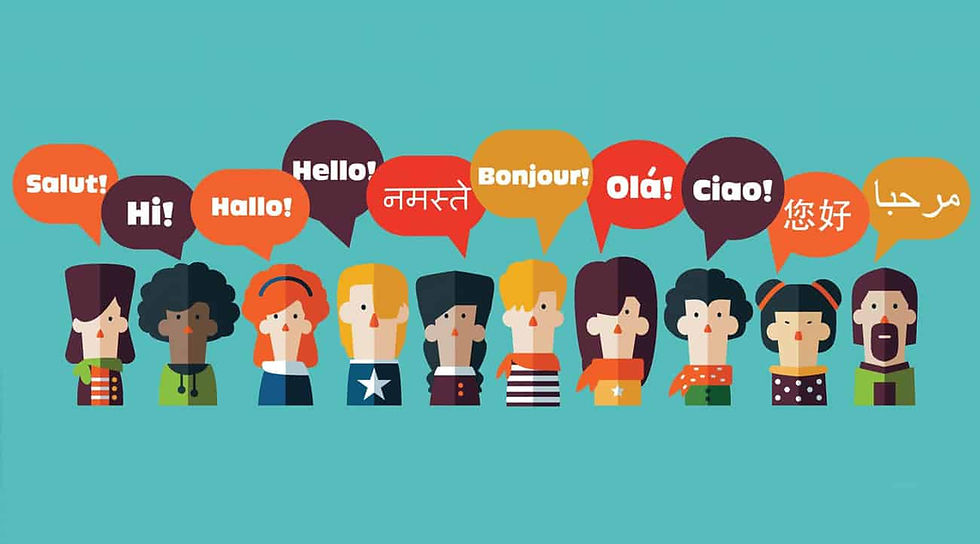Kwik Learning Memory Class 9: Learning Foreign Languages
- Alex Chen
- Feb 23, 2021
- 5 min read
Updated: Feb 28, 2021
How to learn and remember foreign vocabulary in a fast and fun way.
Context:
I’m currently taking the Recall Masterclass from Kwik Learning right now, and as part of the homework, I am to teach what I learned each class to other people. The class is taught by Jim Kwik, a renowned brain coach. Since I’m a blogger, I’d like to share my notes with all of you. I hope you can use the knowledge and practice the methods to improve your memory as well.
Class 9: Learning Foreign Languages

In our interconnected global world, more and more people are interested in visiting other countries and learning foreign languages. This lesson will talk about how to learn and remember foreign languages easier, specifically how to remember vocabulary.
Jim gives the following advice to learn foreign vocabulary easier:
Spaced repetition: review after an hour, a day, a week, a month
Immersion: through a book or a seminar or a culture
Use it (or lose it): use those words in the context of your daily life
Organize it: have flashcards or a language journal
Personalize it: turn it from foreign to familiar
Emotionalize it: the stronger the emotion, the stronger the memory
Movement: write out the words, add body movement
Visualize: Turn the word into a picture
He then goes into detail about three different methods or remembering foreign vocabulary:
Keyword Association
Loci Method
Kinesthetic (Body) Movement
Method 1: Keyword Association
This is a review of the TIP (Turn Into Picture) method from class 3 on remember vocabulary. You can use it to remember vocabulary in your own language or for foreign languages. For review, here are the three steps:
Take the word and turn it into a picture (pretend you’re playing Pictionary)
Take the meaning and turn it into a picture.
Link the two pictures together.
To link the two pictures together in a memorable way, use the 5 vowels:
A = action
E = exaggeration and emotion
I = illogical
O = outstanding
U = unique
Example 1: Polemic = argument
Turn polemic into a picture. Imagine it’s Pictionary. How would you make someone guess the word “polemic”? You can draw a pole and a microphone. So you can imagine a pole with a mic on it. Next, turn argument into a word. Imagine someone shouting at you and arguing with you on the mic on the pole. Next time you see the word polemic, you remember this image to remember polemic = argument.
Example 2: Para Cantar = to sing in Spanish
Turn para cantar into a picture. For para, you can imagine a parachute. For cantar, you can imagine a car full of tar. Imagine in the sky, there’s a car full of tar falling with a parachute, and it’s singing all the way down to you.
Example 3: Pato = duck in Spanish
Turn pato into a picture. Imagine… patting the toe of a duck. Do ducks have toes? Well, if it’s illogical, it’ll be easier to remember!
Example 4: Poulet = Chicken in French
Turn poulet into a picture. Poulet is pronounced pool-lay. Imagine a pool full of lays potato chips, and there’s lots of chicken in the pool pecking on the potato chips.
Example 5: Merci = thank you in French
Turn merci into a picture. Merci is pronounced mare-see. Imagine a mare (a female horse) lost her glasses. You find it and give it to her. She says thank you.
Example 6: Ni Hao = hello in Mandarin
Ni sounds like knee. Hao sounds like ow. Imagine you say hello to a Chinese person, and they hit your knee and you say “how!” instead of ow. It doesn’t have to be exact. The process of working out a story or an association will help you remember it.
Method 2: Loci Method
To review from class 5, the Loci Method is when you create a path in a location, such as your house, that you walk through. As you walk through the path, you notice specific objects in a specific order. You use this path to memorize a sequence of things by turning those things into pictures and then attaching those pictures to your objects.
For example, here’s my Home Loci List:
First is my shoe mat.
Then I walk past my couch.
Then I open my refrigerator.
Then I take something out of the fridge and put it in the microwave.
Then I take it out of the microwave and put it on the table.
Etc.
Let’s say I want to memorize this list:
Good diet
Positive self-talk
Exercise
Brain nutrients
Positive peer group
I would imagine myself entering my front door, and as I take off my shoes, I see lots of healthy food like apples and avocadoes and broccoli on my shoe mat. Therefore, #1 is good diet. Then, as I walk past my couch, I see a proton telling an electron to talk more positively to himself. #2 is positive self-talk. Then I go to the kitchen and open my refrigerator, and inside, I see celery sticks and carrot sticks exercising, doing push-ups and sit-ups and running around. #3 is exercise. I take some carrots and open the microwave, and when I open the microwave, out comes a big plastic brain, and the brain opens and out comes pills and multivitamins. #4 is brain nutrients. I put the plastic brain on the table, and for some reason, I notice my table has a new table cloth with cheerleaders on it saying positive messages like “You can do it!”. #5 is positive peer group.
Now that we’ve reviewed the Loci Method, let’s talk about applying it to learning foreign vocabulary. Since a lot of vocabulary are things we can see in everyday life, we can use turn those words into pictures and then attach them to things we see in our daily life.
For example, let’s say you want to learn vocabulary related to food. You can go to the grocery store. You see eggs. Egg in Spanish is huevos, pronounced wave-ohs. You can imagine yourself putting waves with capital Os on the eggs. The next time you come to the grocery store and you see eggs, you can see waves with capital Os, and that reminds you eggs = huevos in Spanish. You can apply the same idea to a clothing store, or even items in your own home.
Method 3: Kinesthetic (Body) Movement
Jim teaches us how to count from 1 to 10 in Japanese in under 3 minutes by using body movements.
Stand up and say “itchy knee” while scratching your knee. 1= ichi. 2 = ni
2 = ni
Point to the sun and say “san”. 3 = san
Point to the nearest woman and say “she”. 4 = shi
Walk two steps and say “go”. 5 = go.
Pretend you’re rowing a canoe and say “row ku”. 6 = rokku
Sit down and say “sit chi”. 7 = shichi.
Stand up in shock pretending the seat was really hot and say “hot chi”. 8 = hachi
Pretend you’re rocking a baby in your arms while saying “kyu” (cooing sound). 9 = kyu
Pretend you’re putting a jewel ring on your ring finger while saying “jyu”. 10 = jyu
By doing this series of body movements (kind of like a dance), it’s really easy to remember how to count from 1 to 10 in Japanese. The idea is to get creative and link sounds or words to different actions.
Homework
Practice using the Keyword Method to learn foreign language vocabulary.
Practice using the Loci Method to recall foreign language vocabulary in everyday places
Try making body actions for foreign vocabulary
.jpg)
Thank you so much for sharing this information! May your kindness be returned in tenfolds! Much peace to you!